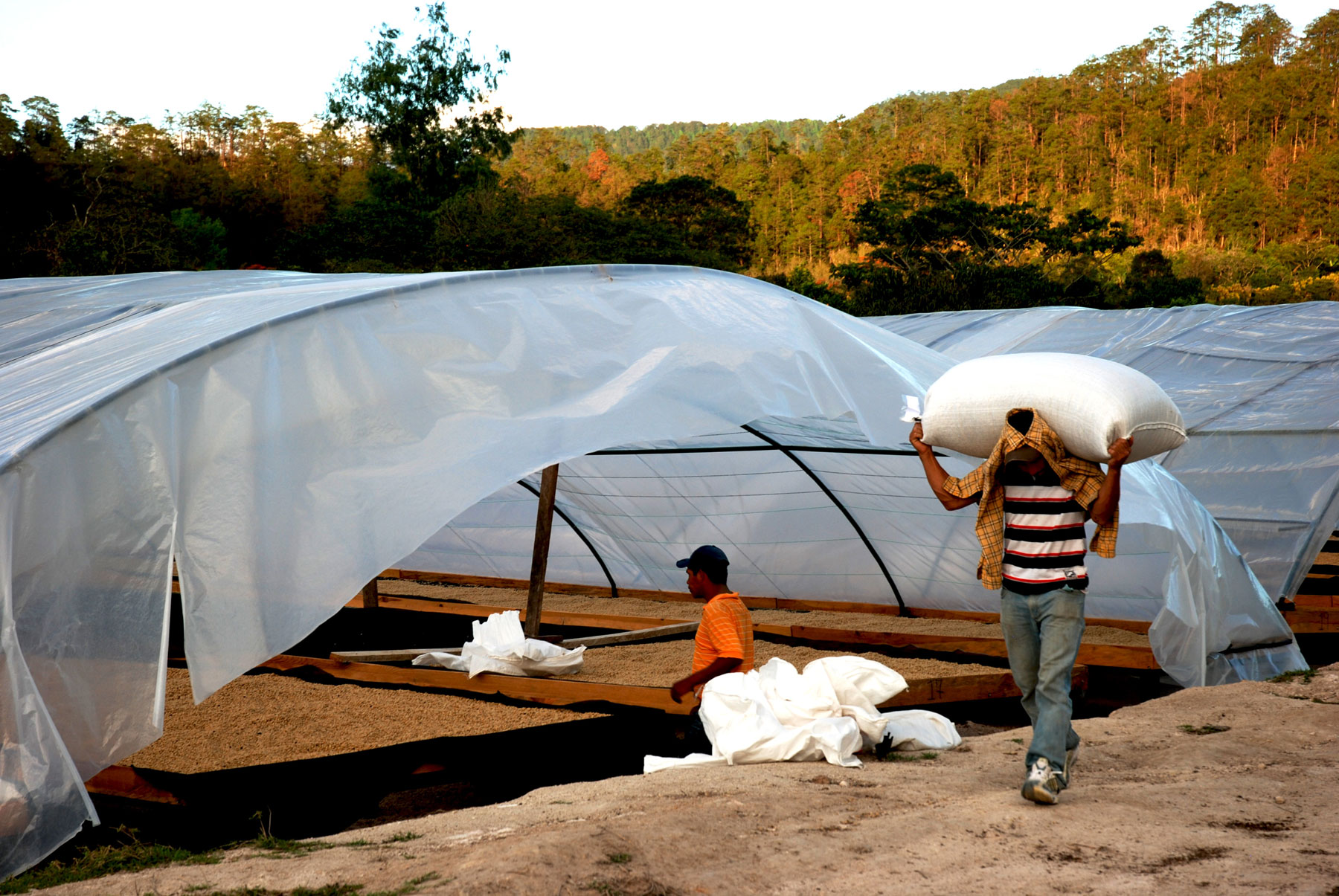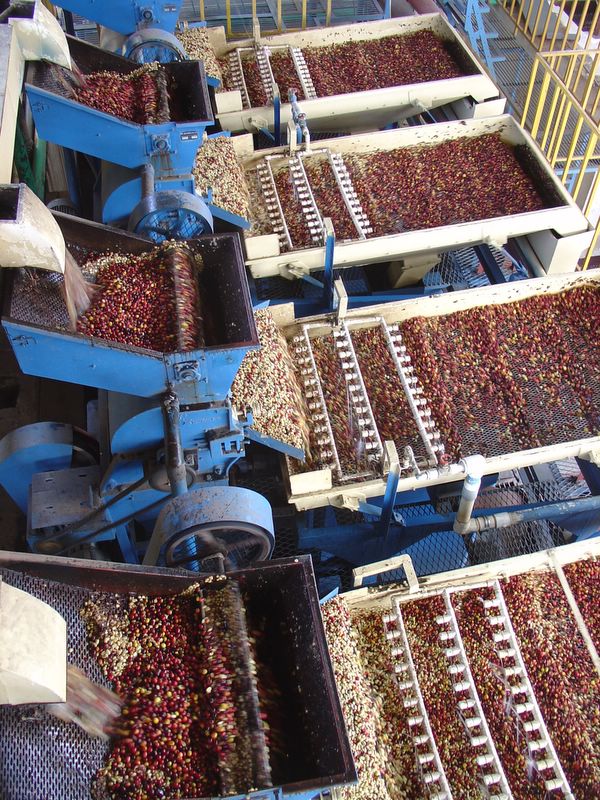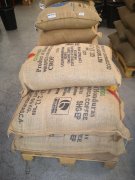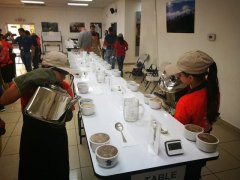Differences between flavor and taste characteristics of coffee beans treated with Honduran honey and washing
Like other Central American countries, coffee culture in Honduras has a long history. Good coffee is an essential part of everyone's day. Coffee is the center of many social occasions.
I like coffee from Central America! At present, there are only two kinds of Honduran coffee in Qianjie store-Shirley and Litchi orchid. From the previous history, there is no Honduran honey-treated coffee. It introduces you to a Honduran honey-treated coffee. Now let's take a look at what is honey-treated coffee. Before we learn about honey processing, let's take a look at what coffee is.
Everyone knows that it is the dried and baked beans (or seeds) of coffee trees. The whole fruit is called coffee fruit, and the coffee beans are located in the middle of the coffee fruit, surrounded by pulp, as shown in this picture of a coffee factory in Seattle. The pulp and other crumbs on the beans need to be peeled off the beans before they can be roasted and made into your daily cup of coffee.
There are two main processing methods of coffee beans. The most common method is to remove the pulp of coffee before drying the beans. This is called wet or water washing because one of the steps in the process is to "wash" the coffee cherries in a vat to help remove the fruit from the beans.
The original method is still common in some countries, dry or natural, drying the whole coffee fruit in the sun. After drying, peel off the pulp and leave the beans. It takes longer to dry the whole coffee fruit than the wet method. Therefore, it needs a very hot, dry environment, and carefully monitor the crop to ensure that it does not over-ferment.

During the processing of honey, the coffee is dried and some or all of the mucus is left on the parchment that wraps the seeds, affecting the sweetness and depth of the coffee. Honey-washed coffee really tastes like someone put honey and brown sugar in your coffee-even though the name actually comes from the stickiness of coffee beans during processing. It has more round acidity than washed coffee, with strong sweetness and complex taste. This natural honey wash has the flavor of watermelon, cherry, strawberry and honey. Sweet, unique, delicious! The honey process aims to have the best of both worlds, while giving consideration to both dry and wet processes. After harvest, farmers peel coffee beans and most of the fruit and dry them.
It is called the honey process because the pulp fragments left on the beans are as sticky and golden as honey. The honey law was originally developed in Costa Rican coffee and is now spreading to other coffee-growing areas in Central America.

During the drying process, some sweetness in the mucus is absorbed into the beans. Compared with the dry method, the drying time is shorter and the risk of overfermentation is lower. Unlike the washing process, the honey process does not use (or rarely use) water. These factors provide farmers with huge environmental and economic benefits. For us coffee lovers, the advantage is that coffee is full-bodied and sweet, with tropical fruit elements and lower acidity than other natural processing methods.
For example, you can study the information about coffee below.
La Guadalupe RedHoney
General information
Variety: bourbon, Catuai, Pacas
Processing: honey
Crop year: 2020
Grade: SHG EP
Certification: fair Trade International, Organic U.S. Department of Agriculture
Origin: Selin Recinos
Finn Kara Guadalupe
Finca La Guadalupe is made up of Don Celin Recinos Sr. Founded more than 80 years ago. Today, La Guadalupe is still a family matter, Selin Recinos Jr. Run the farm into a small wonderland, including Catuai, Pacas, Parainema, Maragogype, Bourbon and tin pickup varieties.
Selin Jr. He has an overall view of how to run his farm, with a focus on reforestation with native species and protecting existing forests and water sources. Selin's concern is not limited to growing coffee, but also growing shade and fruit trees on his farm and home to provide food and shelter for birds and wildlife in the area. In the past few years, the focus has been expanded to include continuous improvement of picking practices and on-site wet grinding. As part of more than 400 organic farmers' cooperatives, Selin also participates in many educational programs on organic farming practices and is an important voice in promoting these practices in local producer communities.
Selin continues to have a positive impact on the dedication and commitment of his farm and community, and the quality of coffee continues to improve. Finca La Guadalupe is an organic food certified by FTO and has been a finalist in the previous Excellence Cup competition.
Important Notice :
前街咖啡 FrontStreet Coffee has moved to new addredd:
FrontStreet Coffee Address: 315,Donghua East Road,GuangZhou
Tel:020 38364473
- Prev

The best flavor and taste of coffee beans in Honduras describe the ranking of native coffee beans in Honduras
Like its Central American neighbors, Honduras is a major coffee-growing area. In fact, it may come as a surprise that Honduras has so far produced and exported more coffee than any other Central American country. In 2020, according to the International Coffee Organization, Honduras produced 6100000 bags of 60 kg coffee. This is the same as 3750000 of Guatemalan coffee
- Next

Honduras small-scale Coffee Cooperation Organization Coffee Sustainable Agriculture Organic Coffee processing
As we all know, many coffee growing areas unite individual farmers in the form of cooperatives to create conditions for coffee cultivation on a small scale. This kind of coffee planting model is actually very popular in Central and South America. Guatemalan coffee and Costa Rican coffee are also used. Here in front street, we will briefly introduce the two Honduran coffee federations.
Related
- Detailed explanation of Jadeite planting Land in Panamanian Jadeite Manor introduction to the grading system of Jadeite competitive bidding, Red bid, Green bid and Rose Summer
- Story of Coffee planting in Brenka region of Costa Rica Stonehenge Manor anaerobic heavy honey treatment of flavor mouth
- What's on the barrel of Blue Mountain Coffee beans?
- Can American coffee also pull flowers? How to use hot American style to pull out a good-looking pattern?
- Can you make a cold extract with coffee beans? What is the right proportion for cold-extracted coffee formula?
- Indonesian PWN Gold Mandrine Coffee Origin Features Flavor How to Chong? Mandolin coffee is American.
- A brief introduction to the flavor characteristics of Brazilian yellow bourbon coffee beans
- What is the effect of different water quality on the flavor of cold-extracted coffee? What kind of water is best for brewing coffee?
- Why do you think of Rose Summer whenever you mention Panamanian coffee?
- Introduction to the characteristics of authentic blue mountain coffee bean producing areas? What is the CIB Coffee Authority in Jamaica?

